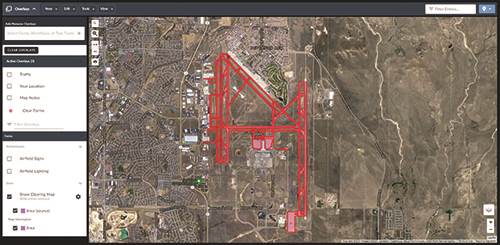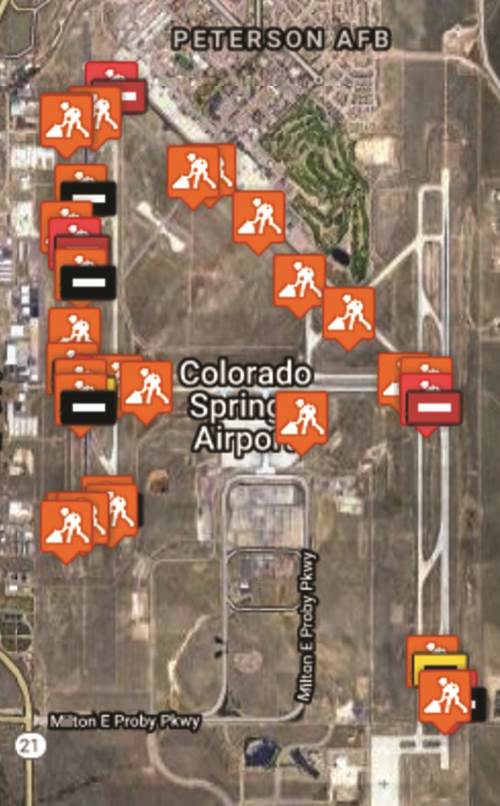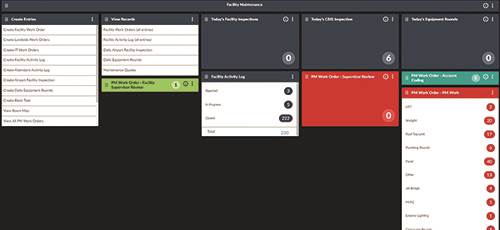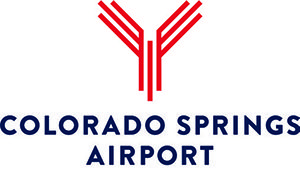To-do lists at Colorado Springs Airport (COS) are no longer paperwork manila files, sticky notes or even email threads. Instead, maintenance tasks and work orders are managed in a sophisticated software program that tracks all aspects of general operations, from airfield and landside to terminal/facilities and information technology.
To-do lists at Colorado Springs Airport (COS) are no longer paperwork manila files, sticky notes or even email threads. Instead, maintenance tasks and work orders are managed in a sophisticated software program that tracks all aspects of general operations, from airfield and landside to terminal/facilities and information technology.

As a result, COS management is finding it easier to monitor work orders through completion, determine costs for parts and labor, track inventory and simplify Part 139 inspections.
“This system required quite a bit of hands-on work to develop, but that is what we liked about it,” says Director of Aviation Greg Phillips. “To create something like this, you’ve got to be open to do the work to make it fit your particular airport. And we are happy with how it worked out. This provides good task notifications and serves as the work order system for our airport.”
|
Project: Central System for Cataloguing Assets & Work Orders Location: Colorado Springs Airport, CO Annual Support Fee: $35,000 Consultant: Veoci
Development/Implementation: Key Benefits: Digital tracking of maintenance & work orders for airfield, landside, terminal/facilities & information technology; data helps management monitor work flow, determine costs for parts & labor, track inventory & plan asset replacement; documentation supports Part 139 inspections; communications module alerts personnel to emergencies Of Note: Program can be customized & changed as needed |
Officials from COS contracted Veoci to develop the software in 2017. The initial work was completed a year later and since then, the airport has relished having its information catalogued into one central system as opposed to different systems in different departments.
“We never had a system that tied everything together from a maintenance and operational standpoint,” says Brett Miller, the airport’s assistant director of aviation. “We had been using an antiquated spreadsheet to track opened maintenance items. We wanted something that could create better efficiencies and tracking as it relates to the bottom dollar so we could make good decisions in relation to airfield and facilities assets.”
One System for Work Orders
The program covers asset and inventory management, inspection and preventive maintenance for four departments: airfield, landside, terminal/facilities and information technology. “We are able to integrate four different work order processes in one system since they use the same inventory and accounting methods with only small differences, explains Alex Nguyen, airports solutions manager for Veoci.
Given the critical nature of Part 139 compliance factors, Airfield-Operations was the first department organized under the new system. It then laid the framework for the rest of the program.
Miller notes that the system’s Part 139 tracking has been especially valuable for COS. Instead of fumbling through piles of paperwork when inspectors ask to review open work orders, personnel are now able to show them the exact status. “It greatly simplifies tracking and displaying historical Part 139 work orders for inspections,” he says.
Switching to the Veoci program required the building team (COS and Veoci personnel) to load all of the airport’s asset information into the system. They also had to gather information related to inventory, inspection requirements and maintenance schedules.


Work orders are automatically triggered for routine maintenance, repairs identified during inspections, visual/technological reporting, etc. Orders with detailed information about what needs to be repaired at specific locations are sent to the maintenance department, where a supervisor reviews them and determines whether each job should be performed, what parts are needed and whether they are in the airport’s inventory.
Employees search for needed parts from a drop-down menu and request them from inventory personnel, who review the requests and authorize parts. The program deducts approved parts from the inventory database and assigns the work orders.
Nguyen highlights the utility of having all work order information in one platform that is available on a mobile app. “No one has to look at a piece of paper or print something out to make sure they have everything they need to do the work,” he says. “All the details are there.”
 The program also documents who performs each job, when it was performed and how long it took before final documentation closed the work order—all valuable information for COS executives. “From an efficiency standpoint, it absolutely improves the airport,” says Miller. “We now have a one-stop shop. If I want to analyze what work orders are out there, how long have they been out there, how much we’ve been spending and the status of our inventory, I can find out with one click of a button.”
The program also documents who performs each job, when it was performed and how long it took before final documentation closed the work order—all valuable information for COS executives. “From an efficiency standpoint, it absolutely improves the airport,” says Miller. “We now have a one-stop shop. If I want to analyze what work orders are out there, how long have they been out there, how much we’ve been spending and the status of our inventory, I can find out with one click of a button.”
Inventory Tracking & Location Mapping
The Veoci program has improved inventory tracking at COS, because the airport’s previous system did not account for costs or the value of existing inventory for new parts, restocking or returns. “Tying our warehouse to the work orders helps determine what is needed to complete a job and track available inventory,” Miller explains. “That information can instantly determine the exact cost of a specific repair.”
Moreover, safety is improved when inventory and work orders are on the same page. “You’re not having to travel back and forth in case you forgot something,” Nguyen says. “The more time one spends on the airfield, the greater the likelihood something could happen. A person should only be out there for a specific reason. They need to go straight there, get the work done and get out.”

The system allows field personnel to use online mapping services such as enterprise Google Maps to pinpoint the location of assets that need to be repaired. “Someone assigned to the work can get an aerial on their mobile device to find the exact location,” Nguyen says. “Previously, the technology was paper. With this tool, they get the aerial map and know exactly where to go. They’re not spending time on the airfield hunting and pecking around.”
 In addition, the system integrates with the airport’s Vaisala sensors that monitor pavement conditions and temperatures. Aerial maps of pavements or roads include transparent boxes that indicate surface conditions. “These boxes change color depending on the conditions being seen,” Nguyen explains. “It’s green if it is dry, but if a contaminant such as water or ice is picked up by the Vaisala sensor, the system changes the colors accordingly.”
In addition, the system integrates with the airport’s Vaisala sensors that monitor pavement conditions and temperatures. Aerial maps of pavements or roads include transparent boxes that indicate surface conditions. “These boxes change color depending on the conditions being seen,” Nguyen explains. “It’s green if it is dry, but if a contaminant such as water or ice is picked up by the Vaisala sensor, the system changes the colors accordingly.”
This supports safety and efficiency, he adds. “On top of completing their work order, they can use the sensors to see what the surface conditions are to determine if they should also do brake testing or something else.”
Data to Drive Decisions
An asset management module tracks preventive maintenance on everything from airfield signs to snow-removal equipment. The program catalogues manufacturer name, model number, purchase date, maintenance schedule, inventory, repair needs and operational costs for each piece of equipment. When the time comes for an inspection or service, the system alerts a supervisor to assign the job.
This allows airport personnel to generate a report about when maintenance needs to be performed on a certain piece of equipment, how much an anticipated repair will cost in labor and parts to the associated cost-benefit analysis on whether older equipment should be replaced.

“When COS looks at their assets now, they can see the preventive maintenance work done on it and all of the work orders that were applied to it,” Nguyen explains. “Because the work orders track costs, we can pull up an item and say, for example, ‘This old jet bridge costs us $40,000 in the past year because of these repairs.’ It gives the airport the big picture of what’s going on with their assets. They can then take this hard evidence to the table to see whether they need to budget and replace an asset because of its costs.”
Emergency Alerts
The communications module in the Veoci system allows COS to issue instant message alerts for situations such as a medical emergency inside the terminal at a specific gate, or an aircraft issue on the airfield. It also monitors weather conditions such as lightning strikes and winter storms. Pre-programmed lists tell the system who should be notified for various emergencies.
Miller notes that improving communications was a priority for the airport. “We’re able to push instant messaging based off the type of situation taking place,” he says, adding that some personnel use radios, but all have smartphones readily available. “The message hits everyone all at once. And as the event transpires, we follow up with additional alert notifications. Of course, there is also the actual physical dispatching and communications with ARFF or law enforcement officers over the radio. But now we can reach out to those who are not directly involved in the operation but probably have a need to know. And we’re able to pull all of them in with one click of a button.”
Such messaging is also helpful during snow events when the airport utilizes Veoci to activate its snow plan and alert staff of snow call outs. Alerts are sent to snow teams regarding forecasted snowfalls, which helps them decide what type of action to take. “When it comes to a snow call out, the system utilizes an automatic dialer and messenger that will automatically alert all appropriate individuals that they need to respond to the airport,” Miller says.
Changes & Updates
The initial cost to build the system was not disclosed, but COS pays Veoci a $35,000 annual support fee. “It’s like a forever build,” Miller says. “And that’s the nice thing with this package—it’s so customizable that you can do the changes and upgrades you want as your operations change.”
Miller and Phillips advise other airport officials interested in a similar system to decide exactly what they want out of it, and to stay actively involved in its construction. “We wanted all our information in one place,” says Miller. “We wanted everything to communicate together. We did not want different work order systems for each department.”
Officials were reminded of the system’s value in March, when Southwest Airlines began service at COS and its overall traffic returned to pre-pandemic levels. With 13 new daily departures from Southwest, the airport now has 33 daily departures.
“The ease and speed in which we can now track issues is a long way from paper documentation,” Phillips remarks. “If an airport hasn’t gone the direction of an automated system like this, it really needs to think about it.”


 facts&figures
facts&figures

